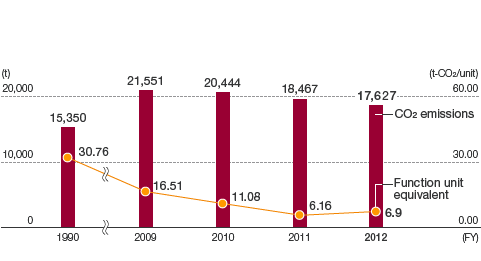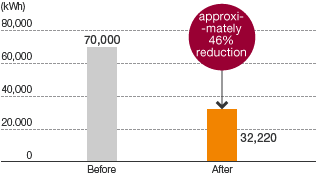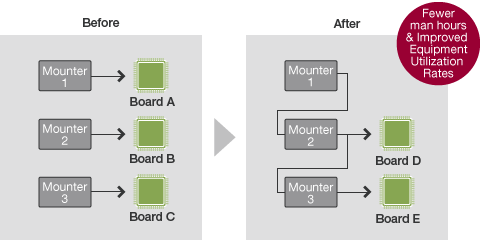 웹 내용 전시
웹 내용 전시

Basic Policy
The Advantest Group regards its efforts toward putting a stop to global warming as part of the corporate mission, and as such works vigorously to reduce greenhouse gas emissions by offering green products and introducing innovative business processes.
The Advantest Group is pursuing medium- to long-range energy conservation measures in alignment with the Japanese government's medium-term goal of reducing greenhouse gas emissions by 25% of 1990 levels by 2020. More urgently, the Group is forging a system to address Japan's revised Act on the Rational Use of Energy and related ordinances, and accordingly implement energy conservation measures.
Fiscal 2012 results
The entire Group is embarking on efforts to achieve our goal of reducing CO2 emissions per unit of production from our business sites in Japan by 85% compared to fiscal 1990, as set forth in the Fifth Advantest Group Environmental Action Plan. Specifically, the Group is working to conserve energy and cut costs by improving production efficiency and reducing waste. In addition, the Group is promoting proper operational control of air conditioning, upgrading outdated facilities into more energy-efficient models, and adopting more environmentally-friendly lighting and LEDs. In terms of our key initiatives during fiscal 2012, we successfully reduced lead times for some of our products and began making more efficient operational control of air conditioner units, thereby slashing power consumption by roughly 128 MWh annually at four of our business locations.
Going forward, we will continue pursuing initiatives to conserve energy and slash costs by reducing waste, and will redouble our efforts to cut CO2 emissions.
CO2 emissions per unit of production

T5773 Memory Test System cuts energy consumption in manufacturing by reducing production lead times
In April 2012, the Advantest Group embarked on initiatives aimed at reducing its environmental footprint in production operations while strictly adhering to delivery deadlines and reducing inventory assets, premised on the slogan “Providing Advantest’s customers with what they need, when they need it.”
As a key measure in this regard we implemented initiatives aiming for a lower rate of defective circuit boards, entailing investigations of incidents involving faulty boards together with relevant divisions, based on the rationale that high defect rates would mean that we would need to check board operability. Accordingly, our efforts resulted in shorter lead times by boosting our throughput yield to over 90%, thereby enabling us to forego the board operability verification process.
Also, we took a close look at ways of making effective use of control equipment, which ultimately led to techniques that now enable us to check multiple product attributes. Consequently, our moves to combine these initiatives with optimized production processes has resulted in significantly shorter production lead times.
As a result of these efforts, we were able to reduce production lead times to seven days using our T5773 Memory Test System, from the 13 days previously required from production to finished product, which in turn has resulted in a production process requiring 36% fewer man hours.
These initiatives also reduced average manufacturing power consumption by 32,220 kWh per month. During fiscal 2013, we will work to apply these successes to other models, in conjunction with our efforts to reduce environmental loads through ever shorter production lead times.
Reduction in energy consumed in manufacturing through shorter production lead times

Efforts to reduce man hours required for set-up in manufacturing of tester boards
Gunma Factory 2 assembles circuit boards used in the Testers. In fiscal 2012, we set out to cut energy consumed in automatic mounting processes by reducing the number of man hours required in Mounter, automatic mounting device for components set-up, when changing products those are assembled before the operation starts.
One challenge we faced in reducing work period required for board assembly was that of automatic mounting processes resulted in the form of lower rates of equipment utilization stemming from the need for more frequent switching boards those are to be assembled.
In an effort to resolve this issue we looked into methods of reducing set-up times required for switching over the board type even for production involving small-lot sizes of many different items. And consequently arrived at the notion, producing more items following a single set-up procedure we could actually reduce the number of set-up operations and time required for production.
Meanwhile, Advantest previously used three modular mounter units operating separately. Set components for each single type of products which was planed to be produced to each Mounter. Approximately 100 different components were used for a single product type, and the set of components were repeatedly removed and attached each time switching over the board type. Therefore, operations involving low-volume production would suggest the prospect of increased equipment downtime with hours required for components set-up exceeding those of Mounter operation.
To rectify this situation, we connected the three Mounter units that had previously operated independently, thereby resulting in triple the number of components that could be produced after a single set-up operation. This enabled production of three to five types of boards following a single set-up. Moreover, by making use of a simulation system to figure out optimal arrangements of components, we were able to avert the prospect of decreased rates of equipment utilization.
We simultaneously introduced a tape feeder to reduce work required in transferring components to the feeder, so that more feeders resulted in less time consumed with set-up and fewer the components loss in process.
These changes resulted in 36 fewer man hours per day consumed in performing set-up when switching over boards those are to be assembled, which translates to a 62% reduction in man hours. This means that modular mounter operation can be handled by fewer employees, five instead of eight, which in turn enables managers to keep the units operational for roughly twice as long by operating the units during other shifts to which the extra employees can be reassigned.
The changes also enabled us to reduce monthly energy consumption from 30,296 kWh to 28,108 kWh, a monthly decrease of 2, 188 kWh which is equivalent to a 9,923 kg decrease annually in CO2 emissions.
Modular Mounter improvements

Lower CO2 emissions through air conditioning upgrades
At the Gunma R&D Center, we have upgraded our meeting room heating equipment by applying inverter technology to existing pumps while adding heat exchangers designed to draw on steam for heat generation. As a result, the entire facility's heating systems now operate more efficiently by steadily raising water temperatures and reducing power consumption.
Furthermore, we uncovered inefficiencies in some freeze prevention control systems of outdoor air conditioning units, and consequently reduced cold water and hot water heat source loads by adjusting hot water valve openings down to 10%, from 50% previously.
These improvements overall have enabled us to slash the facility’s annual power consumption by an equivalent of more than 50 kiloliters of oil, while cutting yearly CO2 emissions by more than 135 tons.


